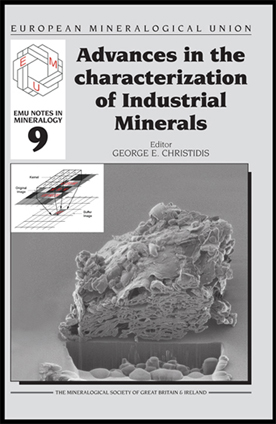
Advances in the Characterization of Industrial Minerals, Volume 9
George E. Christidis, editor
Order Publications Online or by Phone, Fax, Email, Mail
25% discount for MSA, CMS and GS members, except shipping
Mineralogical Society of America, Founded December 30, 1919

Advances in the Characterization of Industrial Minerals, Volume 9
George E. Christidis, editor
Order Publications Online or by Phone, Fax, Email, Mail
25% discount for MSA, CMS and GS members, except shipping
From the Preface
Industrial minerals and rocks are Earth materials utilized because of their characteristic physical and/or chemical properties and not because of their metal content and which are not energy sources. According to this definition they cover a broad spectrum of minerals and rocks which form at all geological environments. The relative importance of industrial minerals to the economy of the various countries reflects the economic maturity of that country and today they constitute the most important raw materials exploited in the developed industrialized countries. The unit value of many industrial minerals is small compared to that of metals and depends on the geographic site from which they are extracted, i.e. they have a large place value. The small unit value also dictates the extent of processing and beneficiation. As they are used by the industry because of their physical and chemical properties, different industrial minerals may often compete for the same applications. In some cases the industrial practice requires production of synthetic industrial minerals, such as zeolites and diamonds, with tailored properties and therefore high added value. Due to increasing environmental awareness, there is need for utilization of waste materials from mining activities, which are also in the mineral form and can thus be considered as industrial minerals. The economic significance of industrial minerals is expected to increase further in the future.
i-xx + 485 pages. ISBN 978-0-903056-28-1.
Contents of Volume 9